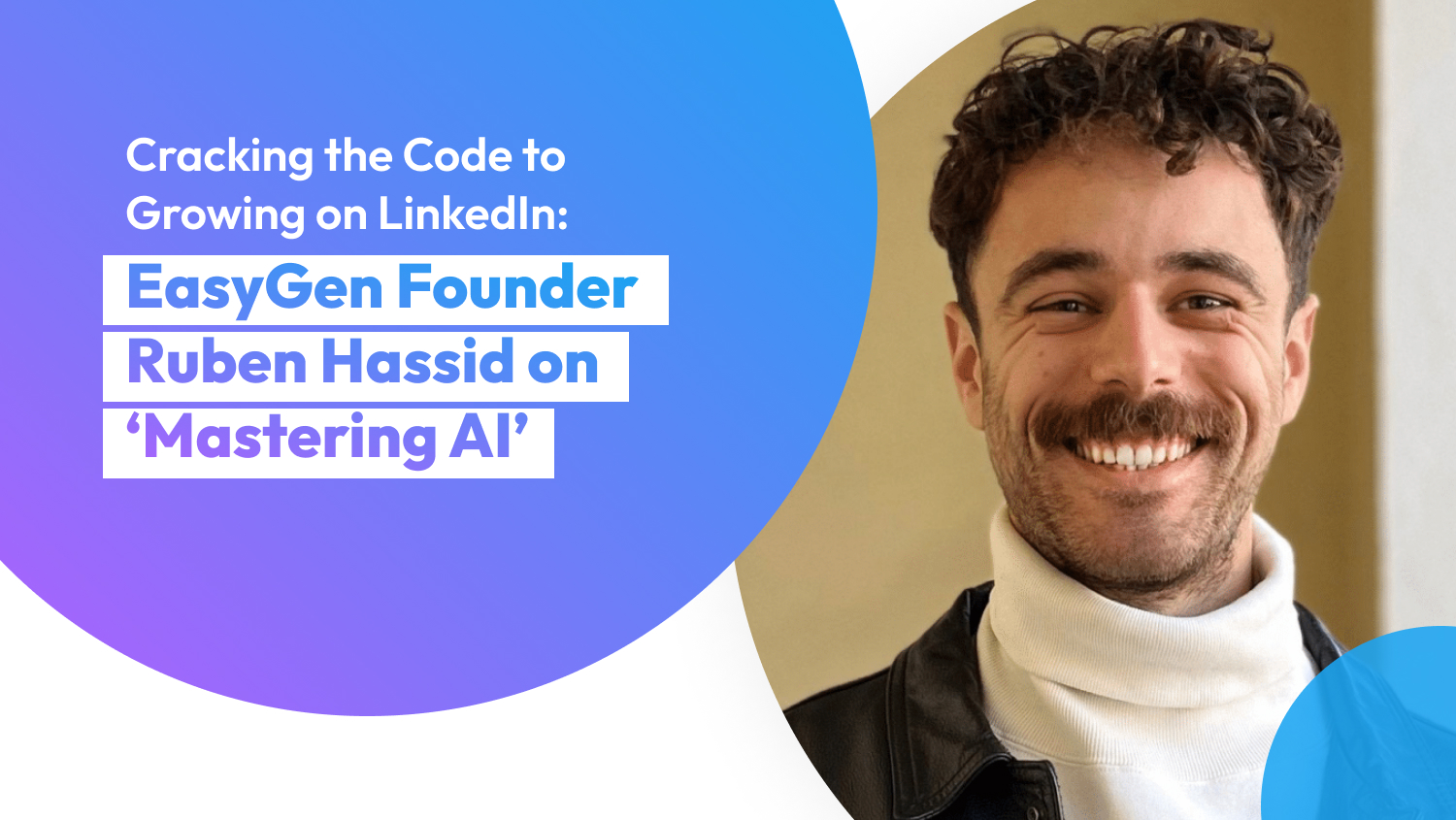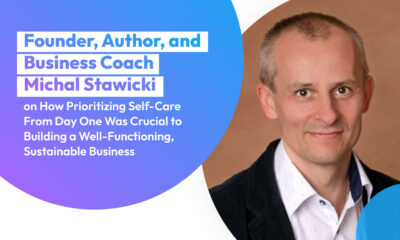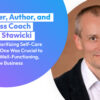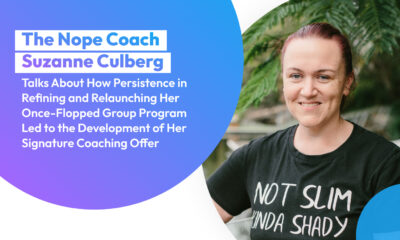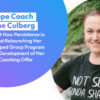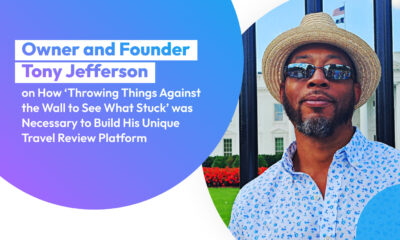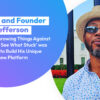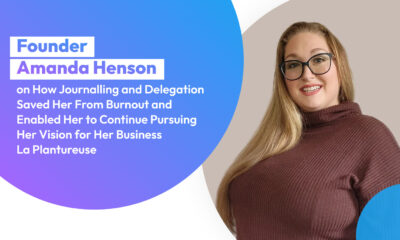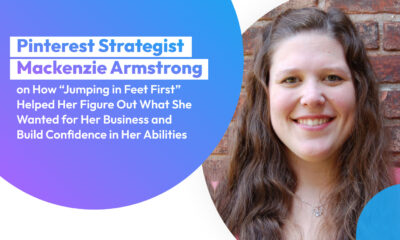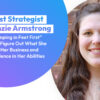Interview
Cracking the Code to Growing on LinkedIn: EasyGen Founder Ruben Hassid on ‘Mastering AI’
Like many of us, Ruben Hassid’s first meaningful encounter with generative AI was when ChatGPT was released in late 2022. In less than two years, he has gone from being a young professional feeling lost in his career to becoming a keynote speaker on AI, a top content creator, and the founder of a promising new tool that can help you go viral on the largest professional networking platform today.
We sat down with Hassid to learn about his journey to creating EasyGen AI, his approach to content creation, and insights on what works (and doesn’t work) on LinkedIn.
Table of Contents
- Lessons in the Power of Audience Building
- Discovering LinkedIn
- Putting Personal Branding to Work
- How One Viral LinkedIn Post Turned into a Tremendous Opportunity
- How to Monetize
- Building a Team Around Content Creation
- Genesis of EasyGen
- What Sets EasyGen Apart
- It’s Not About You
- Wrap Up
- More About Ruben Hassid
Lessons in the Power of Audience Building
Hassid’s first love was music—specifically a niche segment of techno music that needed his help with promotion.
“I was obsessed with techno music at that time. Not the one at Coachella with thousands of people. It was the one from bedroom producers [who] were obsessed with their music. But they had no idea how to get their message across. They didn’t know how to get an audience. They didn’t even know if they had the potential to make a living out of it.
And I just found it fascinating to connect the dots. I had Facebook with Facebook pages, [and] SoundCloud. YouTube was not even that big. So I had to somehow get people from Facebook to SoundCloud so that those DJs could make a living out of it.”
This is where he first saw the power of having an audience, and how creating content on social media can build a following who would happily support an artist or brand. For the next eight years, he ran a couple of music labels that promoted artists through Facebook. They reached millions of views on YouTube and SoundCloud and sold vinyls internationally. He then moved from Paris (his hometown) to Berlin, where he thought he had to be to make it big in the techno music scene.
Discovering LinkedIn
While pushing to grow his music label in Berlin, Hassid took another job in a completely unrelated industry, FinTech. He worked as the international social media manager in one of Germany’s biggest savings and investment platforms. His knowledge of content and marketing made the industry pivot a success, but it wasn’t long before he felt the need to try something different again.
He quit the music business, which kind of sent him into a quarter-life crisis because he had been doing it for so long. After some soul-searching, he realized that connecting with an audience through words, much like what he did for the DJs, and what he does for his FinTech employer, was something he loved to do.
“It took me a lot of time to understand that what I [am] truly passionate about, besides music, is [getting] my message across – not just for me, but for other people. I think that my biggest muscle, ‘brain muscle’, is to write.”
He decided to do a 30-day writing challenge on social media to help him regain focus. “I wanted to write so I [put aside] Instagram, TikTok, YouTube and then I was left with a blog, newsletter, Twitter or LinkedIn. I was spending a lot of time on LinkedIn and liked the fact that there was a lot of educational content. It didn’t matter who I was, if I was good enough to share good educational content on something I was learning or something that I knew, quite a lot of people would connect.”
He also liked that LinkedIn prioritized organic reach, unlike Youtube, Instagram,TikTok or Facebook which are highly dependent on paid ads.
And on LinkedIn, you disclose your real name, work history, and education.. This professional nature of the site creates a more respectful culture. “It’s the only non-anonymous platform. You have way less trolls, because it turns out that if it’s not anonymous, [people stop] talking badly.”
On a related note, Hassid spoke about the difficulty of diversifying platforms (more about his own experience on this later). It’s not just about repurposing and copy-pasting content from LinkedIn to Twitter, or videos from YouTube to Instagram.
“99.9% [of the] population is good just posting on one platform, but being really good at it. Social media is about building an audience and community on one platform. It’s about getting so many reps in on one platform that eventually you know a lot about it.
The only way is to get data in and see what worked and what didn’t. If you try to do this with seven different platforms, then you have no way to get data in because you’re just not doing high quality on all of these. It’s impossible.”
Putting Personal Branding to Work
At first, Hassid wrote about FinTech on his personal LinkedIn account, but soon started sharing what he knew about personal branding and marketing from his years in the music industry. Just a few months into regular posting, he noticed his account (with its modest 3,000 followers) was getting a lot more impressions than his FinTech employer (whose LinkedIn had 40,000 followers).
“Why? Not because I was fancy or crazy or was too lovable. No, it’s just because personal branding works way better. And I wanted to share about that.”
His LinkedIn fame got the attention of a financial analyst who loved his message. He quit his FinTech job and started ghostwriting for this analyst on his Twitter, LinkedIn, and newsletter.
How One Viral LinkedIn Post Turned into a Tremendous Opportunity
As Hassid transitioned to this new career, he found time for a little side project with a friend who was struggling to write a thesis on a highly technical topic. It was around this time that ChatGPT was first released, and he and his friend were impressed with the drafts they were able to produce trying out different prompts.
By December 2022 (he was back in Paris at this point), he was reading the OpenAI documentation, blogs and using ChatGPT itself to understand how this generative AI worked.
“Most of it is technical, so I knew no one was reading it. And no one was making it understandable for people. For example, what is ‘chain of thoughts prompting’? What’s one shot prompting, few-shot prompting, give me examples.”
He wrote up a PDF file summarizing everything he had learned with his deep dive into the OpenAI documentation. He shared it with his followers on LinkedIn and his post got about 1.5 million views.
People started asking for consultations with him, but he decided not to make money from this (yet). He focused on creating more free content on the questions sent to him because he knew there was an audience for it. “From 1 million views, I got 10, then 20, 30, 50 million. In April [2023], I was ranked the second biggest content creator on LinkedIn. It got so big, I got bigger than my [ghostwriting] client.”
At that point, he realized he could take this newfound obsession with generative AI, his love of writing and teaching, and turn it into a new opportunity for himself.
How to Monetize
Within months of his first viral ChatGPT LinkedIn post, Hassid was not only getting paid consultation requests. He was invited as a keynote speaker on AI at various international forums. He put together an online course about everything he had learned about AI and took on brand deals reviewing all types of AI tools.
But then he realized that he couldn’t provide a truly world-class paid course without having to constantly update for developments in the AI space. And he wasn’t comfortable claiming to be an expert or authority on every AI tool that wanted his review.
After asking himself, “What am I good at, and what do I want to get better at?” he decided to focus on audience building. He calculated how many months he could survive writing content about AI without generating any income.
He shares, “If I free my mind from [thinking about making money], I’m going to outperform anyone who is trying to make money and get noticed. Building a personal brand, it’s exactly like a startup. And when you’re a startup, you literally have two leverages. Either you push the button of getting more customers, more customers, more customers. So for me, it’s attention, impressions, followers. Or do I cash out and get the money? [But] monetization and pretty good content that gets impressions, you can’t push the two buttons simultaneously, it’s impossible.
Think about Amazon, [and] Uber. For a very long time, they were not profitable. Because they knew they should acquire, acquire, acquire [customers], and something’s going to happen. Now, the longer you can sustain that, the better it is.”
Building a Team Around Content Creation
With a renewed focus on putting out quality content to expand his reach, Hassid started assembling a team. He already had someone helping him on LinkedIn even while he was still ghostwriting. His first hire helped him manage comments, DMs and put out content.
“The first hiring I recommend doing is on the one platform you’re already good at. Remember, you should nail down one platform. On this one platform, there is a high chance that you already know what you could be doing better. You just don’t have the time or the resources.
Let’s say all of your good posts are carousels, it just takes so long to make them. And you wish you could be on top of your DMs or connection requests.
Hire someone for just that, train them really hard. Yes, the first months, you’re probably going to spend money and not get any return, but there is a high chance that if you get them loyal enough, they’re going to grow and become an extension of yourself.”
With his next hires, he could afford to be a little more experimental. He had the time and the money to figure out how to be effective on Twitter, and he hired a team member to learn along with him. His latest hire was for someone to help him grow on YouTube. With the benefit of a couple of years hiring, training, managing (and firing, he does mention there were a lot of failures along the way), he had figured out his management style and the candidate profile who would thrive in the work culture he creates.
Genesis of EasyGen
As he doubled down on content creation, Hassid struggled to find a good tool to help him write quality LinkedIn posts. So he decided to create his own AI tool. Initially, just for personal use then he let his team, and eventually the general public get access to what he calls a Linkedin Ghostwriter.
He describes the biggest challenge in creating EasyGen was how to make it easy to use. He wanted to take away the burden of crafting the right series of prompts to create viral LinkedIn posts.
“There are many steps behind [the simple user interface], and those steps are my ten years of social media and my two years of obsession with LinkedIn turned into a tool.”
And the proof that it actually works wasn’t just the engagement rate on Hassid’s personal LinkedIn. He managed two of his team members’ LinkedIn accounts and grew their views and following within a couple of weeks using EasyGen.
“When I released EasyGen, I couldn’t tell people, ‘It’s awesome, do it, you’ll have results.’ even though I knew it. Publicly, I said, ‘I’m going to handle my two employees’ LinkedIn. We’re going to try to get to a million views, without ads, no secret, no whatever you want to put inside. Just try to get a million views [organically].’ I thought we would get there by 2025. We got there in 25 days.”
What Sets EasyGen Apart
We got a quick demonstration of how to use EasyGen. Hassid clarifies, “You should not prompt EasyGen, it’s not made that way. It’s actually made in a way that you should do a first draft. For example, you do your research first, then you go on Google Docs and then [start drafting]. I want that step [drafting on Google Docs] to be on EasyGen.”
Hassid emphasizes that ideation and first drafts need to come from the human creator, and the final output is reviewed and edited by the creator as well. He believes this human element is a critical 20% of the process, with the tool doing the 80% of writing and rewriting until the creator is happy with the output.
“Where AI’s power lies is in generating so many variations [of output]. It’s so good at speeding up the process, [but] you’re still the process.”
Hassid also highlighted a few features customers are asking for, but which he doesn’t want to build into EasyGen. One is a scheduling function, and another is analytics on the ‘best time to post.’
“[A] scheduling tool is one of the things that harm your account the most. If you schedule your post tonight, where are you when you post? You’re not on LinkedIn, right? It’s not how social media works. You have to show up for other people, you have to show up for yourself, your own comments, in the DMs and you have to be active before and after posting.
Another feature that all of my competitors do just because it attracts people is to tell you the best moment for you to post. Posting times, yes is important, but I think what’s most important is when can you be active? And when can you make it a habit? You’re focusing on the wrong thing.”
Some modifications are going to be released soon. One of which is to replace the functionality for “Topic Suggestions” with “Idea Generator” – to help users focus on initiating ideation and research. EasyGen will soon be available as a web and mobile app as well, and Hassid wants to include content from his paid membership service where he gives tips on how to write winning LinkedIn content.
It’s Not About You
Hassid had some parting shots about what works on this professional networking platform.
“Most people do it wrong on LinkedIn because they think we care about them. No one cares about you. Yes, personal branding, storytelling, it’s 20%. Eighty percent is, ‘How can you help me?’ People are narcissistic, egoistic.
You can read my last 1,000 posts. You’ll probably have four or five that are personal. Doesn’t mean you never go personal– my newsletter is personal, sometimes my top comments are personal. I kind of want to connect with my audience of course. But LinkedIn is, ‘Help me. Do educational content for me.’”
Wrap Up
Ruben Hassid’s impressive and somewhat unexpected rise to prominence in the AI sphere was the result of always following his curiosity and passions, and going all-in to learn every industry he became part of. Through it all, his obsession with audience building and using content to connect with people has been the driving force behind his success.
One of his key messages is the importance of mastering a single social media platform. Rather than spreading yourself thin trying to be everywhere at once, Hassid recommends becoming an expert on one platform and really learning the ins and outs of what works there.
He offers a very practical perspective of AI in content creation–while tools like EasyGen can streamline the writing process and help you generate viral-worthy posts, Hassid emphasizes that the human element is still crucial. Ideation, research, and final editing should come from the creator, with AI handling the bulk of the writing in between. It’s not about finding a quick hack, but rather using AI to support and enhance your own creativity and hard work.
Finally, Hassid reminds us that at the end of the day, it’s not about you – it’s about providing value to your audience. People on LinkedIn aren’t there to hear your life story; they want educational content that helps them solve problems and grow in their careers or business. By keeping this in mind and consistently showing up with helpful insights, you can build a loyal following and make a real impact on the platform.
More About Ruben Hassid
Founder of EasyGen, the Linkedin ghostwriter.
Reached 120 million people on Linkedin, in less than 2 years.
French, lives in Tel Aviv. International keynote speaker.
Wants you to master AI, before it masters you.
Connect with Ruben here:


